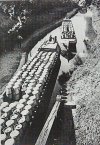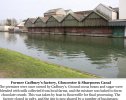View attachment 176673
Canals and waterways by Ware, Michael E Publication date 1987.
“Cadburys was a firm that used the waterways for the transport of raw and processed materials.
This picture postcard issued by Cadburys depicts two horse-drawn boats on the Shropshire Union Canal in the 1920s, having collected milk from canalside farmers for use by the Cadbury factory at Knighton, Staffordshire. They also carried processed materials between Knighton Bournville, and between Frampton on Severn, Gloucestershire, and Bournville.
There was also long-distance traffic from Birmingham to London and Liverpool. At the height of trading the Cadburys fleet numbered seventeen, and their colours were chocolate and maroon…”
 cruisingthecut.co.uk
cruisingthecut.co.uk
 cruisingthecut.co.uk
cruisingthecut.co.uk






